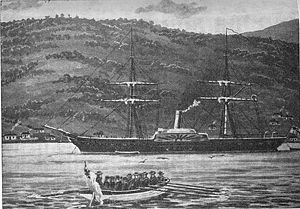HMS Driver (1840)
 HMS Driver
| |
| History | |
|---|---|
| Name | HMS Driver |
| Ordered | 12 March 1840 |
| Builder | Portsmouth Dockyard |
| Cost | £39,707 |
| Laid down | June 1840 |
| Launched | 24 December 1840 |
| Commissioned | 5 November 1841 |
| Fate | Wrecked on 3 August 1861 |
| General characteristics [1] | |
| Class and type | Driver-class wooden paddle sloop |
| Displacement | 1,590 tons |
| Tons burthen | 1,055 62/94 bm |
| Length | 180 ft (54.9 m) (gundeck) |
| Beam | 36 ft (11.0 m) |
| Depth of hold | 21 ft (6.4 m) |
| Installed power | 280 nhp |
| Propulsion |
|
| Sail plan | Brig-rigged |
| Complement | 149 (later 160) |
| Armament |
|
HMS Driver was a Driver-class wooden paddle sloop of the Royal Navy. She is credited with the first global circumnavigation by a steamship when she arrived back in England on 14 May 1847.[2][3]
Construction and commissioning
Driver was ordered on 12 March 1840 from Portsmouth Dockyard to a design by Sir William Symonds. She was laid down in June 1840 and launched on 24 December 1840, with her machinery being supplied by Seaward & Capel of Limehouse, Woolwich. Her hull cost £19,433, with the machinery costing another £13,866. After she had completed fitting out, at a further cost of £6,408, she was commissioned on 5 November 1841.
Career
Driver was driven ashore at Steel Point, Yorkshire, on 28 November 1841, and was later refloated.[4] She embarked for the East Indies and China in March 1842. She served some time in China (losing her original commanding officer) before being ordered to New Zealand in September 1845. She was damaged by a storm en route, necessitating repairs to her engine and boiler and other parts of the ship.[3]
During her circumnavigation Driver became the first steamship to visit New Zealand, arriving on 20 January 1846,[5] and was involved in the Hutt Valley Campaign, which was part of the New Zealand Wars. At the time of her visit she was described as a brig-rigged 6-gun warship displacing 1,058 tons with engines rated 280 horsepower.[6]
Driver set off east from New Zealand for her return journey to England via Cape Horn on 28 January 1847. She stopped for six days in Argentina to pick up more coal, finally arriving in Portsmouth, England on Friday 14 May 1847, 105 days after starting from New Zealand. Of the ship's original officers, the second in command Lieutenant Thomas Kisbee, the master, purser, surgeon and assistant surgeon completed the entire circumnavigation.[3]
On 11 March 1850 she was docked in Victoria Harbour to witness Richard Blanshard assume the Governorship of the newly formed Colony of Vancouver Island, and issued a seventeen-gun salute.[7]
Fate
She was wrecked on 3 August 1861 on Mayaguana Island, the most easterly of the Bahamas, in the West Indies.[1] She was on a voyage from Bermuda to Jamaica.[8]
Citations
- ^ a b Winfield (2014), p. 160.
- ^ History Channel: This day in history - May 14 Archived 13 May 2008 at the Wayback Machine
- ^ a b c "Arrival Of The Driver Steam-Sloop From New Zealand". London Standard. p. 4 – via British Newspaper Archive.
- ^ "Ship News". The Times. No. 17843. London. 2 December 1841. col C, p. 7.
- ^ New Zealand Maritime Museum Archived 5 January 2009 at the Wayback Machine
- ^ New Zealand Electronic Text Centre
- ^ "City of Victoria - History". Archived from the original on 15 April 2009. Retrieved 3 February 2010.
- ^ "Shipping Intelligence". Liverpool Mercury etc. No. 4233. Liverpool. 5 September 1861.
References
- Colledge, J. J.; Warlow, Ben (2006) [1969]. Ships of the Royal Navy: The Complete Record of all Fighting Ships of the Royal Navy (Rev. ed.). London: Chatham Publishing. ISBN 978-1-86176-281-8.
- Winfield, Rif (2014). British Warships in the Age of Sail 1817–1863: Design, Construction, Careers and Fates. Seaforth Publishing. ISBN 978-1-84832-169-4.
